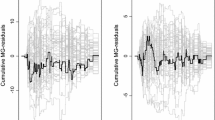Abstract
Incomplete covariate data is a common occurrence in many studies in which the outcome is survival time. With generalized linear models, when the missing covariates are categorical, a useful technique for obtaining parameter estimates is the EM by the method of weights proposed in Ibrahim (1990). In this article, we extend the EM by the method of weights to survival outcomes whose distributions may not fall in the class of generalized linear models. This method requires the estimation of the parameters of the distribution of the covariates. We present a clinical trials example with five covariates, four of which have some missing values.
Similar content being viewed by others
References
A. Agresti, Categorical Data Analysis, Wiley: New York, 1990.
G. Falkson, A. Cnaan and I. W. Simson, “A randomized Phase II study of acivicin and 4'Deoxydoxorubicin in patients with hepatocellular carcinoma in an Eastern Cooperative Oncology Group Study,” American Journal of Clinical Oncology vol. 13, pp. 510–515, 1990.
G. Falkson, S. Lipsitz, E. Borden, I. W. Simson, and D. Haller, “A ECOG randomized Phase II study of beta Interferon and Menogoril,” American Journal of Clinical Oncology vol. 18, pp. 287–292, 1994.
J. Ibrahim, “Incomplete data in generalized linear models,” Journal of the American Statistical Association, vol. 85, pp. 765–769, 1990.
J. Ibrahim and S. Weisberg, “Incomplete data in generalized linear models with continuous covariates,” Australian Journal of Statistics vol. 34, pp. 461–470, 1992.
J. F. Lawless, Statistical models and methods for lifetime data. Wiley: New York. 1982.
R. Little and M. Schluchter, “Maximum likelihood estimation for mixed continuous and categorical data with missing values,” Biometrika vol. 72, pp. 497–512, 1985.
T. Louis, “Finding the observed information matrix when using the EM algorithm,” JRSS-B vol. 44, pp. 226–233, 1982.
I. Meilijson, “A fast improvement to the EM algorithm on its own terms,” JRSS-B vol. 51, pp. 127–138, 1989.
M. Pugh, D. Harrington, S. Lipsitz and J. M. Robins, “A Simulation Study of an Estimator of Relative Risk in the Cox Model with Missing Covariate Data.” Division of Biostatistics, Dana-Farber Cancer Institute, Boston, MA, Technical Report No. 777Z, 1993.
J. M. Robins, A. Rotnitsky and L. P. Zhao, “Estimation of regression coefficients when some regressors are not always observed,” JASA vol. 89, pp. 846–866, 1994.
M. Schluchter and K. Jackson, “Log-linear analysis of censored survival data with partially observed covariates,” Journal of the American Statistical Association vol. 84, pp. 42–52, 1989.
Author information
Authors and Affiliations
Rights and permissions
About this article
Cite this article
Lipsitz, S.R., Ibrahim, J.G. Using the EM-algorithm for survival data with incomplete categorical covariates. Lifetime Data Anal 2, 5–14 (1996). https://doi.org/10.1007/BF00128467
Received:
Accepted:
Issue Date:
DOI: https://doi.org/10.1007/BF00128467




